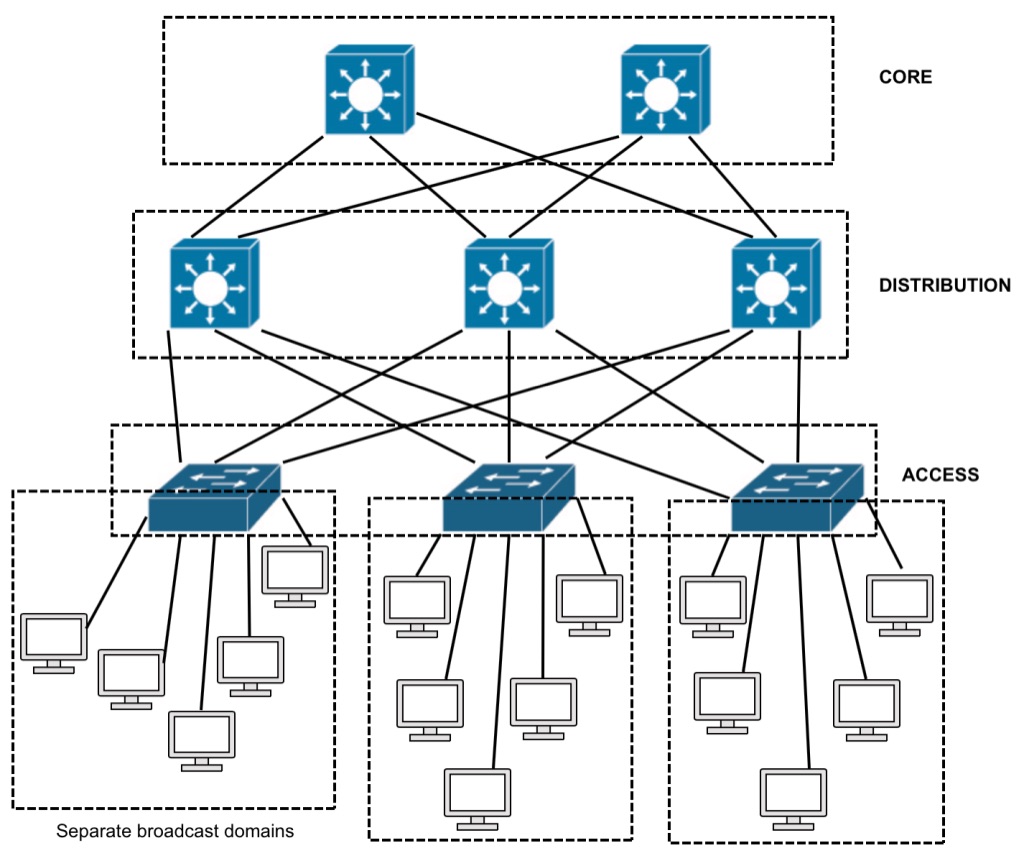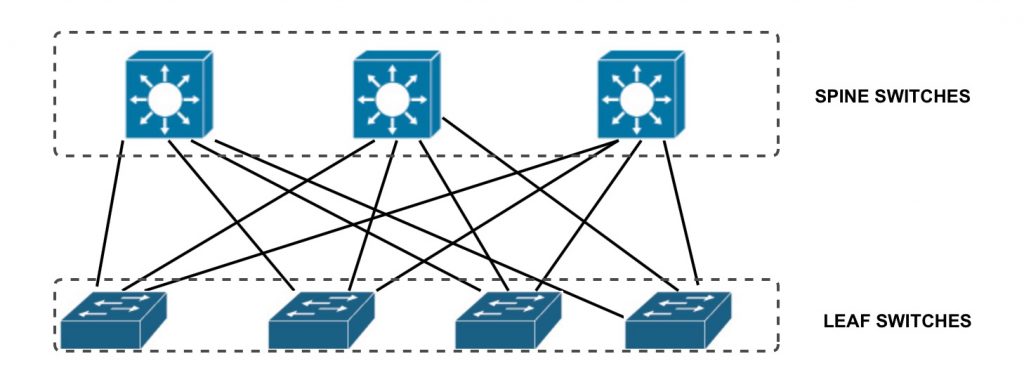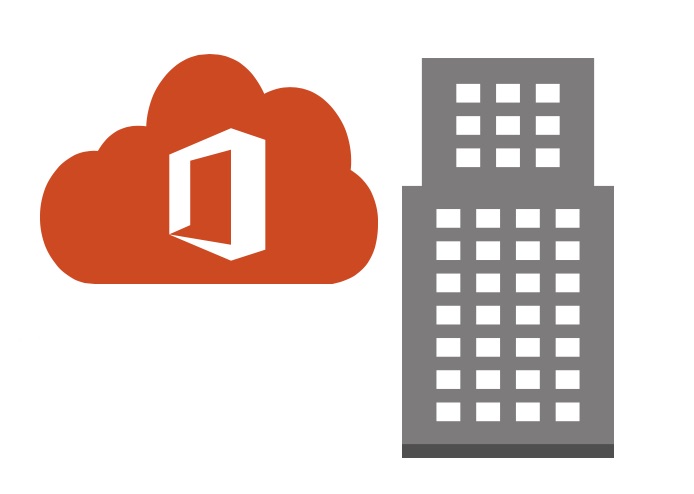Welcome back idol! Dito sa free ccna lesson natin for today, pag-uusapan natin ang topic about network topology and some common network designs.
Sabi ko nga, unahin natin mga basic and fundamentals para magkaroon tayo ng foundation sa mga future lessons.
What is network topology?
Ang network topology ay ang arrangement, structure or design naman ng isang network. Ito ang nagpapakita or nagpapaliwanag kung papano magkaka-connect ang mga devices (physical) or kung papano dumadaloy ang data or traffic sa isang network (logical).
Ang physical topology ay yung pagkaka-ayos ng mga devices or components ng isang network kasama na ang physical location ng mga devices pati na rin ang cable installation. This is what we see with our eyes.
Let say nagpunta tayo ng data center, kung ano ang nakikita natin na pagkaka-ayos or pagkakasunod-sunod ng mga devices at iba pang network equipments, that’s what we called physical topology.
Samantalang ang logical topology naman ang nagpapakita kung papaano nga tumatakbo or dumadaloy ang data or traffic sa isang network regardless of its physical design.
So ibig sabihin, hindi naka-batay sa physical na location, pagkakasunod-sunod at iba ang magiging takbo ng data or traffic kapag logical design ang pinag-uusapan. We can only see this by verifying the configuration of the network.
In the old network model and design, mga simple at basic lang ang topology na meron tayo pagdating sa network. Andiyan ang tinatawag natin na bus topology(all devices are connected to a single line of connection), ring topology(a circular design), star topology, mesh and more. Pero eventually, it evolves and new network design or architectures has been adapted.
Cisco Hierarchical Network Design
Ang Cisco ay may recommended network design or hierarchy ng topology ng isang network. Sa pamamagitan ng design or topology na ito, mas optimize at maiiwasan ang failure of connection ng mga devices. Maiiwasan ang “downtime” or interuption sa network.
Let’s see.

Ayon kay Cisco, recommended na magkaroon ng division ang isang network into discrete layers gaya ng nakikita natin sa larawan(sa taas). This is also called the three-tier design. As you can see, we have three different layers or “tiers” of devices. The access, distribution and the core layer.
Each layer or tier sa network ay may kanya-kanyang function na nagde-define ng kanyang role sa kabuuang design ng network. Ito ay makaka-tulong sa isang network engineer sa pag-optimize, pagpili ng mga model ng devices at mga features nito, kasama na rin ang pagtro-troubleshoot kapag may issue sa network.
Let’s see the basic understanding of each layer.
1. Access layer
Sa isang LAN environment, ang mga access layer devices ang nagco-connect ng mga end devices sa network. Ang mga PC, servers, printers at iba pa ay naka-connect sa mga access layer devices (example access switches).
Ang ilan sa mga functions nito ay layer 2 switching na na-explain natin kung pano gumagana ang isang switch, high availability, port security at iba pa.
Si Cisco ay meron ding designed na devices or different models na nararapat para sa access layer gaya ng Cisco catalyst 2960, 3560, 3650 or 3850 at iba pa depende sa laki ng network or organizations.
2. Distribution layer
Ang mga nasa distribution layer devices naman ang bahalang mag-manage ng data or traffic galing sa mga devices sa access layer bago ito makarating sa final layer or core layers kung kinakailangan.
Sa mga malalaking company, segragated ang network sa ganitong design para mas optimized ang network at madaling magtroubleshoot kung kinakailangan.
Meron ding recommended na devices or model si Cisco para sa distribution layer depende rin sa laki ng network or environment. Example is Cisco Catalyst 6500 or 6800.
3. Core layer
Ang core layer naman ang nagsisilbing “backbone” ng network. Dito naka-connect ang mga devices sa distribution layer kung saan naman naka-connect din ang mga devices na nsa access layer. Mga advance or yung mga high end model of devices ang mga nsa core layer since designed sila to process traffic faster and optimized.
Halimbawa din dito ay ang mga Cisco Catalyst 6500 or 6800 or mas mataas pa depende sa environment. Usually ang core layer ay connected na sa mga edge routers or devices palabas ng isang network (either internet or remote network location).
Having or following the three-tier design recommended by Cisco is a good thing. Ang problema, it can also cost a lot. From the design, devices and support, hindi ito practical sa ibang enterprise or organizations. This is where a practical design or architecture comes in, at ito ang tinatawag natin na two-tier design or architecture. Sometimes it is also called a collapse core design.
Here’s how it looks like.

As you can see, halos kapareho lang din nung naunang design natin pero this time we only have two tier or two layers. That is the access layer and the distribution layer(minsan core layer ang ginagawang distribution).
So the function is almost the same. We connect all end points and end devices sa ating access layer(which is mostly our access switches) and then ang mga switches na yun ay connected sa ating distribution or core layer(combined as one).
Kadalasan, dito rin naka-connect ang mga critical devices natin sa distribution layer like our servers. Ang mga vlans natin ay dito rin natin ginagawa sa ating distribution layer. We can also do our internal routing here. The only time na kailangan lumabas ng “data” or packet natin is when it needs to go outside our local area network or LAN.
This way, na-implement ang recommended design or architectures ni Cisco na redundant and efficient network pero still being practical.
Ganitong design din ang hinahawakan at mina-manage namin dati. Although our company has multiple branches in and out of the country, this two-tier or collapse core design is very effective and scalable.
Small Office / Home Office
Pagdating sa real world, hindi naman lahat ng company or organizations can avail or follow Cisco hierarchical model. Kahit pa sabihin natin na practical ang two-tier or collapse core.
Bakit?
Well, unang-una, hindi naman lahat ng businesses ay kailangan ito. Pangalawa, it cost a lot. Pangatlo, they also need a knowledgeable I.T person/s to support those technologies. That’s why it is very important to assess the needs and goals of the company or organization before applying that design and buying those devices.
Meron din tayong tinatawag na small office / home office network design or architecture. And this is where small offices or home offices comes in.
For example, a small office can probably have only several employees supporting the operation of their business. Sabihin na natin na kailangan lang nila ng network printer, scanner at connection sa internet.
Sa tingin mo ba kailangan pa nila ng mga mamahaling Cisco devices?
Hindi di ba?
They just probably need(for now) a plug and play devices na kagaya ng meron tayo sa mga bahay natin.
Ang mga pangkaraniwang devices lang na ginagamit or meron sila ay laptops, desktops, printers, scanners, copying machine, cctv cameras, and a simple server. If we’re running a small business at home, this can also be the same set-up. This can be connected and run good even on an “unamanged devices”.
So in our given example, a small office network can look like this.

From that design, we can achieve and provide the needs of this small office. Pero once the business grows and needs more resources, that’s where we can start to adapt the other model or design. Pero hindi ibig sabihin, we will jump agad-agad sa mga mamahalin at advance the mga devices.
For example, if the business needs to have a redundant connection sa internet para meron fail over. We can connect a new ISP and setup redundancy. When the need arises at kailangan na talaga, we can have voip implemented so the employees can use ip phones. This time, the business may need to have a voice gateway and avail a voice line from the provider too.
If the business continuous to grow, at magkakaroon ng ibang branches(or a work from home options), a vpn can setup or maybe kakailanganin na din ang mas secured na connection like private and leased lines. Different needs can come in kapag talagang lumalago at lumalaki na ang organization or business.
Actually, wala naman talagang “perfect” design for all or “fit for all” networks. It always depends on the needs and goals of the company or organizations. As a network engineer or network administrator, we need to be aware of those goals and needs para makapag-design tayo ng maayos at efficient na network.
Spine-leaf
Sa mga naunang designs or architectures na pinag-usapan natin, they are commonly applied in an enterprise or small offices. Pero as the technology evolved, cloud and data centers technology arises too. Dito pumapasok at ginagamit ang spine-leaf(or leaf-and-spine)design or architecture.

Meron tayong backbone, which acts or serve as the spine(this can be layer 3 switches) at ang mga layer 2 switches (or devices) natin sa mga “data center racks” which act or connected as the leaf.
Every leaf switches is connected sa spine switches natin giving a single hop para sa mga servers or other devices na connected sa leaf switches if they need to communicate.

Pagdating sa spine-leaf, in most cases, ang flow ng traffic natin ay sideways(sa mga naunang designs na pinag-usapan natin, ang “traffic flow” ay upward) dahil nga ito ay designed for cloud and data centers.
I-imagine mo yung patong-patong na mga serves at switches sa data centers, they are all inter-connected sa isa’t isa and they have a very-fast connection. In a bird’s eye view, it really looks like a spine of a leaf di ba?
Pero since this design and architecture is mostly for data centers, I haven’t had any “hands-on” experience designing this type of network.
Although our company before has multiple data centers, collocation(where you rent a data center tapos andun yung mga devices niyo) and multiple branches, the three-tier and two-tier(collapse core) pa rin ang ginagamit namin dati. Gaya nga ng nabanggit ko, it always depends on the needs and goals of the organization.
Cloud and on-premise

As the technology evolves and business adapts, “connecting everywhere” in network also becomes a norm. At hindi lang sa network, pati na rin sa mga softwares at ibang resources natin sa buong I.T infrastructure.
Dati, ang mga organization “hosted” its own servers, devices, applications even the whole infrastructure itself. Ibig sabihin, kung kailangan ng business ng ganitong technology, they have to acquire and manage those devices, applications and infrastructure on their own. Even the support. It’s called on-premise.
Sa on-premise design, ibig sabihin, the company or organization host and manage its own infrastructure to support the needs of the business. Kagaya nga ng nabanggit ko, mga servers, network devices, applications and more, control at hawak nila mismo in their organization.
Today, hindi na ganun. Cloud technology has been introduced and being adapted in the industry. Although hindi pa naman fully-adapted, it seems na diyan tayo papunta in the future.
When it comes to cloud technology or cloud architecture, we can rent the devices, the applications, the services or even the whole infrastructure itself for our business needs. Ibig sabihin, “we use it” pero it is being manage and maintain by other people.
A great example of cloud technology or architecture are AWS(Amazon Web Services), Google Cloud and Microsoft Azure. Through this cloud technology, you can build/rent an infrastructure, devices, application, services na kailangan ng business or organization mo.
There are common cloud services(service models) na makikita at available sa industry natin ngayon. Ito yung mga pangkaraniwang makikita natin.
- IaaS or Infrastructure as a Service
- PaaS or Platform as a Service
- SaaS or Software as a Service
When it comes to IaaS, it only provides the network and delivers computer infrastructure. Most common cloud providers of these services as Amazon Web Services and VMWare.
Pagdating naman sa PaaS, hindi lang network ang kasama sa services kundi pati na rin ang operating system. It deliver computer platform and computer stack allowing the clients or customers to develop, run and manage applications. Microsoft Azure is a good example for this kind of service.
For SaaS, it comes on all needs. So kasama ang network, operating system and software. Microsoft office 365 naman is a good example for SaaS.
There are also different cloud computing technologies when it comes to deployment. These are the follwing:
- Private
- Public
- Hybrid
I know you probably know how it works. The only difference is that hybrid deployment is a combination of private and public cloud services being used/deployed by an organization. Hindi na natin iisa-isahin ang mga ito.
These are the basics of cloud computing/services technology. Napakalawak ng topic na ito at hindi na natin kailangan himayin for CCNA. I just provided you the fundamentals.
Pero sabi ko nga kanina, hindi pa lahat nag-aadapt in the cloud technology. Although it has many advantages, it also comes with some dis-advantages like control and security.
Imagine all your data and information(together with the data and information of your customers) are being manage and maintain by other people. As we always talk on this blog, it always depends on the needs and goals of the organization.
Wheew!
This is one of the longest lesson we have so far.
I hope by this far, you now understand the fundamentals of network topology and design.
In the CCNA Masterclass, we cover this in great details and examples. If you’re interested in joining our community, send me an email or watch ka rin sa mga emails na isini-send ko kasi I always announce enrollment on emails.
Ready to go with the next lesson?
sir ang galing po sana my update kau hehehe thanks a lot ksi dami ko natutunan sa blog mo i’m currently studying cisco for ccna and the way you share your ideas is awesome. thanks po ulit more powers ^.^
Thank you mark! Continue learning Please share na rin sa iba para mas marami pa tayong matulungan. Cheers!
Tuloy niyo lang sir ang pag bblog wala man masyado nagbabasa sa ngaun pero dadami dn to balang araw hehe . ngaun lang ako napadpadpad dito pero dami agad ako natutunan 🙂 keep it up Sir.
Yeah, more to come so stick around! Thank you!
Tama po. Tatapusin nyo po ba mga lessons dito.soon..ang ganda. Nya kc basahin lng beses na ko ngbabasa pero mas gets ko mga topics nyo..ilove this blog…
Yap Mechel. Kumpletuhin natin yan in time, just stick around. Thank you.
Grave boss busog na busog yung utak sa blog nio. . Mahal lng talaga ang bootcamp d2 sa cebu. . If makapunta ka nang.cebu at my free seminar. . Wag kalimutang mag invite. .hehe gsto q talaga mag network eng. .kaso mahirap lng eh. .yan lng poh salamat sa lahat sir billy, pagpalain kayu nang dyos na mai kapal! Ingat poh,
Welcome idol. Salamat din!
sir salamat sa blog na to this will be a great help for us.. god bless sir
Welcome idol Perseus. Godbless!
thumbs up! refreshes my ccna training from rivanIT. keep on posting bro younger peeps would learn for free here on your blog. Thank you and more power
Thanks idol!
idol mark, kamusta namn training sa rivanIT ? magbootcamp dn ako sknla this sept. eh hihi salamt
Sir Salamat Sa pag Share ng info.. Lulubusin ko na Ask ko lang sana anu ung device after ng Core Switches? Firewall na po ba? Inaaral ko kasi ung network ngaun kasi binigyan aq ng assignment ng boss ko. Network Design For 200 users with 5 Departments 😀 ok ung design ng cisco.
Kung palabas, edge router mna then firewall (ung logical na flow ng traffic). Thanks!
hi po ulit, tanong ko lang po, ano po ba ang pinagkaiba ni CISCO at ni Mikrotik? alin ang mas madali?
Malaki. Different company different devices, different configuration. Cisco is the leader in enterprise networking.
Salamat sa mga informations sir na na i-share ninyo. More power po
Welcome Carlo!